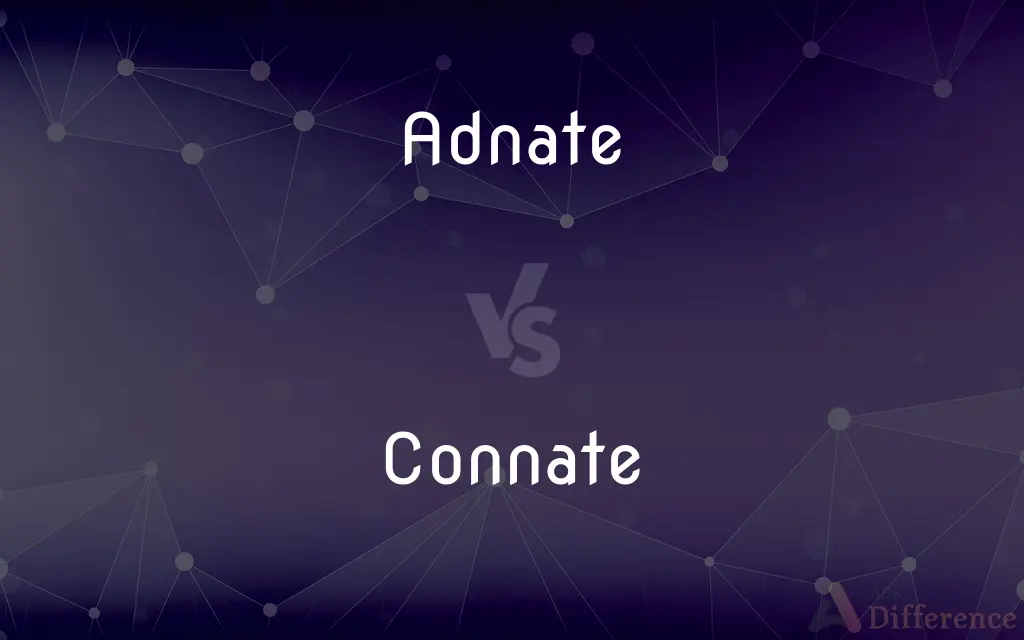Adnate vs. Connate — What's the Difference?
By Tayyaba Rehman — Updated on October 31, 2023
Adnate is when different structures grow firmly together, whereas connate refers to structures that are united or fused naturally from birth.

Difference Between Adnate and Connate
Table of Contents
ADVERTISEMENT
Key Differences
Adnate is a term often used in botany to describe a situation where different plant structures, such as leaves or stems, grow tightly adhered to each other, though they are not naturally born attached. Connate, in contrast, describes structures that are united from the very beginning, as they were inherently grown together from the onset of development. Both terms indicate a form of union, but the origin of their connection differs.
In describing anatomical parts, adnate suggests a secondary fusion, where parts that are not typically connected have grown to be so over time. Connate, however, implies a congenital union, where parts grow as a single unit from the start. Thus, while adnate may indicate a grafting or adherence after initial development, connate suggests a developmental condition that is intrinsic and foundational.
When two different leaves grow together along their margins after they have developed, they are referred to as adnate, showcasing an attachment that was not present at the beginning of their growth. In contrast, connate leaves are those that have developed fused together right from the bud stage, signifying an innate connectedness. Both adnate and connate convey the concept of connectivity in plant structures, yet they differ in the timing and process of this connection.
In the context of botanical morphology, an adnate petal would be one that has become joined to another part of the flower, like the calyx, after the initial formation. Conversely, connate petals are those that have been united since they first appeared on the plant, reflecting a natural condition rather than an acquired one. Although both adnate and connate can be observed in flowers, the distinction lies in whether the union is original or subsequent.
Understanding the terms adnate and connate is crucial for botanists in describing the relationships between plant parts. An adnate condition suggests a form of secondary connection, not essential to the initial plant design, whereas connate describes a primary condition of growth, essential and integral from the plant's emergence. Therefore, both terms are used to articulate the nuances of plant structure and development with precision, each indicating a different kind of unity.
ADVERTISEMENT
Comparison Chart
Definition
Structures joined after development.
Structures naturally joined from inception.
Origin of Union
Secondary; post-developmental.
Primary; congenital.
Botanical Example
Leaves attached to a stem later in growth.
Petals fused together from the bud stage.
Morphological Process
Fusion or adherence occurring with growth.
Innate fusion, present from earliest growth phase.
Implication in Description
Indicates a non-inherent connection.
Indicates a natural, inherent connection.
Compare with Definitions
Adnate
Fused to a different type of organ or structure later in development.
Leaves adnate to the branch only in adulthood suggest a peculiar growth pattern.
Connate
Naturally united or fused with a similar part.
The twin stems were connate, growing as one from the seedling stage.
Adnate
In mycology, describing gills that are broadly attached to the stalk of a mushroom.
The mushroom’s gills were adnate, a characteristic key to its identification.
Connate
Present at birth or innately joined.
The connate petals of the flower were a striking example of natural symmetry.
Adnate
Botanically, describing an organ growing closely attached to another organ.
The stamens were adnate to the petals, forming a unique floral structure.
Connate
Describing parts that have grown together from the very beginning.
The connate sepals formed a protective layer around the developing bud.
Adnate
Attached or fixed closely to something else, not naturally part of it.
The fungus was adnate to the bark, almost seeming as one with the tree.
Connate
Biologically, referring to structures that are united from development.
The connate roots of the saplings made transplanting them a delicate process.
Adnate
In lichenology, referring to the thallus that is firmly attached to the substrate.
The adnate lichen spread across the rock’s surface, tightly clinging to its host.
Connate
Existing at birth or from the beginning; inborn or inherent.
Adnate
Joined or united with a part or organ of a different kind, as stamens attached to petals.
Connate
Originating at the same time; related.
Adnate
Linked or fused to a structure of a type different from itself; for example, attachment of a stamen to a petal is adnate, while attachment of a stamen to another stamen is connate.
Adnate mushroom gills are broadly attached to the stalk slightly above the bottom of the gill, with most of the gill fused to the stem.
An anther is adnate when fixed by its whole length to the filament.
Connate
Being in close accord or sympathy; congenial
"In the wilderness, I find something more dear and connate than in streets and villages" (Ralph Waldo Emerson).
Adnate
(zoology) Growing with one side adherent to a stem; applied to the lateral zooids of corals and other compound animals. in fish, having the eyes fused and unable to rotate independently
Connate
(Biology) Joined or united with a structure of the same kind, as sepals or petals.
Adnate
Grown to congenitally.
Connate
(Geology) Trapped in sediment or rock at the time of deposition
Connate water.
Adnate
Growing together; - said only of organic cohesion of unlike parts.
An anther is adnate when fixed by its whole length to the filament.
Connate
Of the same or a similar nature; proceeding from the same stock or root.
Adnate
Growing with one side adherent to a stem; - a term applied to the lateral zooids of corals and other compound animals.
Connate
Inborn.
Adnate
Of unlike parts or organs; growing closely attached;
A calyx adnate to the ovary
Connate
(botany) United with other organs of the same kind (for example sepals connate with sepals, petals connate with petals, or stamens with stamens).
Connate
(geology) Trapped within a rock at the time of its formation (especially of water or petroleum).
Connate
Born with another; being of the same birth.
Connate
Congenital; existing from birth.
A difference has been made by some; those diseases or conditions which are dependent on original conformation being called congenital; while the diseases of affections that may have supervened during gestation or delivery are called connate.
Connate
Congenitally united; growing from one base, or united at their bases; united into one body; as, connate leaves or athers. See Illust. of Connate-perfoliate.
Connate
Of similar parts or organs; closely joined or united;
A connate tomato flower
Connate
Related in nature;
Connate qualities
Connate
Inherent or congenitally fused, as in organs of a plant.
Botanists noted the connate leaves that formed the plant's base.
Common Curiosities
What does connate mean in botany?
In botany, connate refers to plant parts that are naturally united from inception.
What does adnate mean?
Adnate describes a part that is joined to a dissimilar structure later in development.
Can adnate apply to human anatomy?
Typically, adnate is used for botanical or mycological contexts, not human anatomy.
Is adnate fusion always permanent?
Adnate fusion is generally stable but can vary based on the plant or fungal species.
How is adnate identified in plants?
Adnate is identified when non-similar plant parts, such as a stem and a leaf, are unusually joined.
Can adnate occur in animal structures?
Adnate typically describes plant or fungal structures and is not commonly used for animals.
Can connate parts ever be separated?
Connate parts are usually integral to each other and not meant to be separated.
Is adnate attachment common in mushrooms?
Yes, many mushrooms have adnate gills attached to their stalks.
Are connate features a result of evolution?
Yes, connate features can be the result of evolutionary adaptations for survival.
What is a real-world example of connate?
The fused petals of many flowers are real-world examples of connate structures.
Are connate and adnate synonymous?
No, connate implies a natural, inherent connection from birth, while adnate is a secondary connection formed later.
Can connate traits be artificially induced?
Connate traits are natural; however, selective breeding can enhance these traits in plants.
Is connate a genetic trait?
Yes, connate traits are genetically determined and manifest from the earliest stages of development.
Does adnate only occur in certain environments?
Adnate can occur in various environments; it's more about species-specific growth patterns.
Share Your Discovery

Previous Comparison
Pattern vs. Trend
Next Comparison
Swelling vs. EdemaAuthor Spotlight
Written by
Tayyaba RehmanTayyaba Rehman is a distinguished writer, currently serving as a primary contributor to askdifference.com. As a researcher in semantics and etymology, Tayyaba's passion for the complexity of languages and their distinctions has found a perfect home on the platform. Tayyaba delves into the intricacies of language, distinguishing between commonly confused words and phrases, thereby providing clarity for readers worldwide.















































